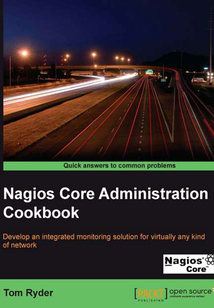舉報 

會員
Nagios Core Administrators Cookbook
最新章節:
Index
ThisbookiswritteninCookbookstyle,beginningwithrecipesbasedonbasicstructurewhichgraduallyprogressestowardsusingNagiosCoreasamonitoringframework.ThisbookisforSystemAdministratorswhoarelookingforrecipestohelpthemdealwithadvancednetworkmonitoringissueswithNagiosCore.
目錄(118章)
倒序
- coverpage
- Credits
- Nagios Core Administration Cookbook
- About the Author
- About the Reviewers
- www.PacktPub.com
- Support files eBooks discount offers and more
- Preface
- What this book covers
- What you need for this book
- Who this book is for
- Conventions
- Reader feedback
- Customer support
- Chapter 1. Understanding Hosts Services and Contacts
- Introduction
- Creating a new network host
- Creating a new HTTP service
- Creating a new e-mail contact
- Verifying configuration
- Creating a new hostgroup
- Creating a new servicegroup
- Creating a new contactgroup
- Creating a new time period
- Running a service on all hosts in a group
- Chapter 2. Working with Commands and Plugins
- Introduction
- Finding a plugin
- Installing a plugin
- Removing a plugin
- Creating a new command
- Customizing an existing command
- Using an alternative check command for hosts
- Writing a new plugin from scratch
- Chapter 3. Working with Checks and States
- Introduction
- Specifying how frequently to check a host or service
- Changing thresholds for PING RTT and packet loss
- Changing thresholds for disk usage
- Scheduling downtime for a host or service
- Managing brief outages with flapping
- Adjusting flapping percentage thresholds for a service
- Chapter 4. Configuring Notifications
- Introduction
- Configuring notification periods
- Configuring notification for groups
- Specifying which states to be notified about
- Tolerating a certain number of failed checks
- Automating contact rotation
- Defining an escalation for repeated notifications
- Defining a custom notification method
- Chapter 5. Monitoring Methods
- Introduction
- Monitoring PING for any host
- Monitoring SSH for any host
- Checking an alternative SSH port
- Monitoring mail services
- Monitoring web services
- Checking that a website returns a given string
- Monitoring database services
- Monitoring the output of an SNMP query
- Monitoring a RAID or other hardware device
- Creating an SNMP OID to monitor
- Chapter 6. Enabling Remote Execution
- Introduction
- Monitoring local services on a remote machine with NRPE
- Setting the listening address for NRPE
- Setting allowed client hosts for NRPE
- Creating new NRPE command definitions securely
- Giving limited sudo privileges to NRPE
- Using check_by_ssh with key authentication instead of NRPE
- Chapter 7. Using the Web Interface
- Introduction
- Using the Tactical Overview
- Viewing and interpreting availability reports
- Viewing and interpreting trends
- Viewing and interpreting notification history
- Adding comments on hosts or services in the web interface
- Viewing configuration in the web interface
- Scheduling checks from the web interface
- Acknowledging a problem via the web interface
- Chapter 8. Managing Network Layout
- Introduction
- Creating a network host hierarchy
- Using the network map
- Choosing icons for hosts
- Establishing a host dependency
- Establishing a service dependency
- Monitoring individual nodes in a cluster
- Using the network map as an overlay
- Chapter 9. Managing Configuration
- Introduction
- Grouping configuration files in directories
- Keeping configuration under version control
- Configuring host roles using groups
- Building groups using regular expressions
- Using inheritance to simplify configuration
- Defining macros in a resource file
- Dynamically building host definitions
- Chapter 10. Security and Performance
- Introduction
- Requiring authentication for the web interface
- Using authenticated contacts
- Writing debugging information to a Nagios log file
- Monitoring Nagios performance with Nagiostats
- Improving startup times with pre-cached object files
- Setting up a redundant monitoring host
- Chapter 11. Automating and Extending Nagios Core
- Introduction
- Allowing and submitting passive checks
- Submitting passive checks from a remote host with NSCA
- Submitting passive checks in response to SNMP traps
- Setting up an event handler script
- Tracking host and service states with Nagiosgraph
- Reading status into a MySQL database with NDOUtils
- Writing customized Nagios Core reports
- Getting extra visualizations with NagVis
- Index 更新時間:2021-08-05 18:12:20
推薦閱讀
- ETL數據整合與處理(Kettle)
- SQL Server 2008數據庫應用技術(第二版)
- Enterprise Integration with WSO2 ESB
- Hadoop大數據實戰權威指南(第2版)
- Python醫學數據分析入門
- 數據庫原理與應用(Oracle版)
- 中國數字流域
- 企業級數據與AI項目成功之道
- MySQL 8.x從入門到精通(視頻教學版)
- 從0到1:JavaScript 快速上手
- 圖數據實戰:用圖思維和圖技術解決復雜問題
- 云數據中心網絡與SDN:技術架構與實現
- Unity 2018 By Example(Second Edition)
- MySQL數據庫技術與應用
- Web Services Testing with soapUI
- Python數據分析從小白到專家
- 計算機視覺
- 深入理解Flink:實時大數據處理實踐
- 數據會說話:活用數據表達、說服與決策
- Learn Selenium
- Kafka權威指南(第2版)
- 工業大數據分析實踐
- Hands-On Meta Learning with Python
- 實用推薦系統
- 大數據運營與管理:數據中心數字化轉型之路
- PostgreSQL 9X之巔(原書第2版)
- Power BI數據分析與數據可視化(微課版)
- Spark 3.0大數據分析與挖掘:基于機器學習
- 大學計算機基礎(第2版)
- 智能數據:如何挖掘高價值數據

